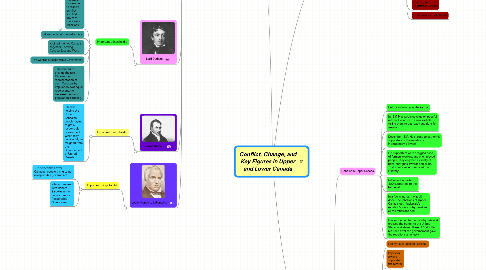
1. Key Figures that cause the conflicts and change to Upper and Lower Canada.
1.1. William Lyon Mackenzie
1.1.1. Important things he did
1.1.1.1. -He was the leader of the rebellion for Upper Canada. This is the most important thing he did
1.1.1.2. -Many people disliked him for what he wrote in the newspaper about his enemies. He wrote in articles calling his enemies "Nobodies" so a lot of his enemies hated him
1.1.1.3. -He got re-elected into the assembly 4 times
1.1.1.4. -He supported the Reform Party. Reform Party is the party that wants to help change the rules of Upper Canada so it's more equal but his party lost. He blamed the lieutenant-general for supporting the opposing party. So he decided that a revolution was the answer. So that is when he started the rebellion, hoping to change the rules.
1.2. Louis-Joseph Papineau
1.2.1. Important things he did
1.2.1.1. -He was the leader of the rebellion for Lower Canada. This was his most important thing he did.
1.2.1.2. -He supported the reformers and he thought that the elected assembly should have more power then the appointed parts of government. So he travelled to England to convince the British to change the laws. He was unsucessful.
1.2.1.3. -He published the ninety two resolutions. This was a list that demanded for reforming Lower Canada.
1.2.1.4. -When people finally found out that the peaceful way of resolving things won't work, people rebelled and Papineau was the leader
1.3. Sir Francis Bond Head
1.3.1. Important things he did
1.3.1.1. -Interfered with the elections and betrayed the reformers and support the Torries. (another election group)
1.3.1.1.1. New node
1.3.1.2. -Pretended to help support the refomers but secretly was supporting another group
1.4. Lord Durham
1.4.1. Important things he did
1.4.1.1. -Was sent to Upper and Lower Canada by the British Government to resolve conflict and find out why there were rebellions
1.4.1.1.1. New node
1.4.1.2. -A supporter of the Reformers.
1.4.1.3. -Joined the two Canada's together. Forming Canada East and West
1.4.1.4. -He wanted a Responsible Government
1.4.1.5. - He wanted to change the rule. Choose the representation of each Canada's by Population. Not equal reperesentation because the French population is too big.
1.5. Robert Baldwin
1.5.1. Important things he did
1.5.1.1. -He was helping the Upper Canadian people, trying to get a responsible government. When they declined it, he resigned from the Governement of United Canada.
1.6. Louis-Hippolyte LaFontaine
1.6.1. Important things he did
1.6.1.1. -He helped the Lower Canadian people,trying to get a responsible government.
1.6.1.2. -He also worked with Robert Baldwin in the Legislature for Responsible Government
2. Changes
2.1. Minor Changes
2.1.1. Apointed some of the Politicans
2.1.2. Must Accept what the elected polticans requested
2.1.3. Any bill that is passed on by the Legislative Assemble has to become law
2.1.4. If the Lieutenant Governor doesn't sign the bill. It is not a law.
2.1.5. Changed Lower and Upper Canada to Conada West and East
2.2. Major Changes
2.2.1. Responsible Government was granted
2.2.2. Voters get to choose Government representatives. So the Voters got to vote for which candidate to take which position
2.2.3. Abolished the positions of Lieutenant General, Executive Council, and Legislative Council
2.2.4. No More apointed officals
3. Conflict
3.1. Conflict in Upper Canada
3.1.1. Led by William Lyon Mackanzie
3.1.2. In 1837 Mackanzie gave up on peceful reform. He wrote in a news article telling them to get ready and fight for freedom.
3.1.3. December 1837. He started to gather his supporters of the rebellion at Montgomery's Tavern.
3.1.4. His supporters were a ragged band of farmers,workers, and unemployed people. They only had a variety of rifles, shotguns, swords and clubs. That is very weak compared the Miletary.
3.1.5. In December he led 400 supporters to the battlefield.
3.1.6. In a few minutes, it was all done. The rebellions of Upper Canada lost. Mackanzie's rebellion's were outgunned and all the rebellions fled.
3.1.7. Mackanzie fled to the country side and crossed the border to the United States and stayed there till 1849. He returned after the governement gave the rebellions amenesty.
3.2. Conflict in Lower Canada
3.2.1. Led by Louis-Joseph Papineau
3.2.2. Papineau always supported the reform.
3.2.3. in 1832 Joseph tried to peacefully resolve the conflict at first. He travelled to London England to persuade the Government in Britian to change the system in lower Canada. The British government rejected though
3.2.4. He spent years trying to increase support for reform. In 1834 he published the Ninety-Two Resolutions. The Ninety-Two Resolution was a list that demanded the people to reform lower Canada. But it didn't work.
3.2.5. In 1837 the Russell Resolutions proved that changing things in the peaceful way doesn't work. A rebellion was formed and a big fight was unleashed.
3.2.6. In November of 1837 an armed group of Patriote (Papineau supporter) captured a Seigneur's manor. The Army failed at retrieving the manor and the rebellion had a victory. Rebellion-1 Government-0
3.2.7. The Army doesn't give up that easily. Two days after the Patriote captured the manor, the army approached a rebellion camp filled with 100 rebellions. The army attacked and assassinated most of the rebellions at the camp. Now Rebellion-1 Government-1
3.2.8. In Mid December Sir John Colborne a commander of the British Army led a group of 1200 Soilders to raid a Patriote camp. The rebellions tried to defend themselves but they were no match against the army. In the end 100 rebellions died and a lot of them were taking Prisoner. Now Rebellion-1 Government-2 The government defeated the rebellions again. These were the main conflicts
